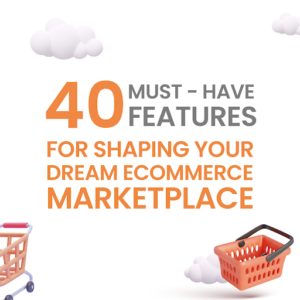Shipping is one of the most important parts of operating a Multi-Vendor Marketplace. The setup, speed and experience can make or break the experience of customers and sellers in the Marketplace.
There are various decision points here, and the answers depend on numerous factors like the maturity of your Marketplace, skillset of Vendors, customer behaviour on your website, location of your Warehouses and commercial viability.
We can broadly divide this problem into the following parts:
- What kind of shipping methods do you want to offer your customers?
- How much do you charge your customers on checkout? How do you calculate it?
- Who pays for the Shipping / whose Shipper account is used for creating labels?
- Where do the Vendors want to process their orders – on your dashboard or on their website backend?
- How do you account for the Shipment charges at the time of Payout? Both the charge collected from the customer and the shipping charge levied by the Shipper need to be considered.
At Shipturtle, we have many options to configure your desired workflows. Many of them are not offered by default by website platforms like Shopify and are custom offerings from Shipturtle. Let’s review the above questions individually, and layout possible options.
What kind of shipping methods do you want to offer your customers?
There are broadly 3 kinds of shipping options which you can offer to your customers –
1. Ship standard or expedited
The most common option, is merchants offer a customer option to ship by surface or air and can charge accordingly. How to configure – This option can usually be configured using Shopify’s native feature of Shipping Profile.
2. Ship using a preferred carrier
In some cases, merchants offer the customer the choice to select their Shipping carriers like FedEx or UPS. Typically used for time-sensitive and expensive parcels where customers have a view on which shippers are safer or cheaper. How to configure – This option needs a feature for “Carrier calculated shipping rate” or “3rd party live shipping rate” – available only on advanced Shopify plans and needs a custom app. Read more – 3rd party rate calculator.
3. Pickup the product from the warehouse
Used in hyperlocal, community or peer-to-peer marketplaces, merchants offer the ability to pickup the goods directly, usually for free. How to configure – This is a complex solution and requires custom development. Shopify by default requires pickup settings to be configured at the Location level where Products need to be assigned to that location. This cannot be managed by Vendors themselves. Also, this does not work in checkout baskets with products belonging to different sellers. Typically this setting can only be used along with a Split Cart feature and 3rd party rate calculator.
How much do you charge your customers on checkout? How do you calculate it?
The decision for what amount you want to charge your customers on checkout is a very important business decision. Customers worldwide are often more sensitive to the shipping cost than the product cost since while the latter is something they “get”, the former is something they “spend”. With that important insight out of the way, here is what most customers do in decreasing order of frequency.
- Bake Shipping price into the Product. Offer Flat or Free shipping at checkout.
How to configure – This option can usually be configured using Shopify’s native feature of Shipping Profile. - Offer Tiered shipping prices basis the Order value in the cart or the weight of all the products in the basket.
How to configure – This option can usually be configured using Shopify’s native feature of Shipping Profile. However in a Marketplace environment, it is not possible to set these rates at Vendor level in Shopify. To sell Vendor specific Shipping Profile, use the feature Marketplace Shipping Profile. - Charge Actual Shipping prices by collecting the actual shipping rate charged by the shipper at checkout.
How to configure – This option needs a feature for “Carrier calculated shipping rate” or “3rd
The ” party live shipping rate” is available only on advanced Shopify plans and needs a custom app. Read more – 3rd party rate calculator.
Where do the Vendors want to process their orders – on your dashboard or on their own website backend?
Shipturtle offers all Vendors the ability to operate on a Cloud login and sync their website on it using our Vendor Sync functionality.
1. Cloud dashboard
For vendors using the cloud dashboard, all options outlined in the article so far are possible where they can integrate their accounts or take labels made by the merchant.
2. Vendors Syncing their Website
In this case, it mostly makes sense that the Vendors fulfill their orders on their website admin. Shipturtle does an automatic sync of the tracking information with your marketplace.
There are possibilities for the Marketplace to also make the shipping labels in this case, but it leads to complexity and is not suggested.
How do you account for the Shipment charges at the time of Payout?
At the time of generating Payout to the Vendor for the orders fulfilled, the Marketplace has to consider what he received as Shipping charges from the customer at checkout vs the cost he had to bear for shipping (if integrating own carrier)
1. Transfer Shipping charges collected to the Vendor
Applicable when the Vendor pays for the shipping
How to configure – Manage Product Commissions
2. Keep the Shipping charges collected
Applicable when the Marketplace pays for the shipping
How to configure – Manage Product Commissions
3. Charge the Vendor for the actual shipping cost incurred
In many cases, the Marketplace does not charge the customer for shipping or charges a nominal amount (covered in Point 2 above). In such cases, they may choose to pass on the cost of the actual shipping label to the Vendor. How to configure – This is a use case that Shipturtle supports only as a custom development due to its high complexity.
Summary
Shipping is a vast and complex setup in D2C and Marketplace and Dropshipping. Choose your approach carefully and remember that you can change it as your business progresses! Take simple approaches first to avoid complexity and build your Sales.


